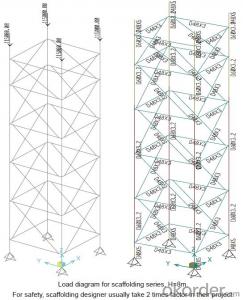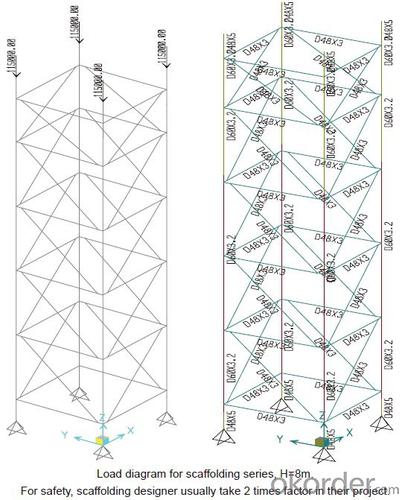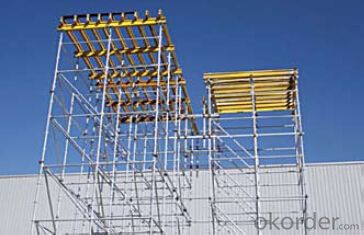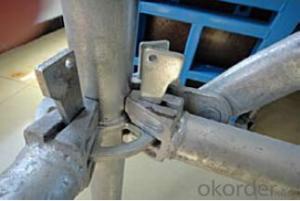Ring-lock scaffolding Accessories for formwork and scaffolding system
- Loading Port:
- Tianjin
- Payment Terms:
- TT OR LC
- Min Order Qty:
- 50 m²
- Supply Capability:
- 1000 m²/month
OKorder Service Pledge
Quality Product, Order Online Tracking, Timely Delivery
OKorder Financial Service
Credit Rating, Credit Services, Credit Purchasing
You Might Also Like
Ring-lock Scaffolding
A support system for construction, ownsadvantages of both cup-lock scaffolding andshoring tower.
It is in the development direction of new typescaffolding.
It is widely used in buildings, bridges, tunnels etc..
Characteristics:
◆ Easy to storage and transportation
◆ High degree of standardization
◆ Easy and quick erection
◆ Excellent stability and bearing capacity
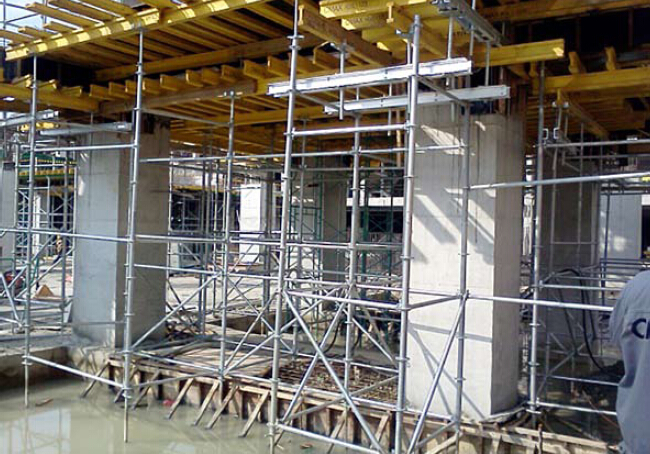
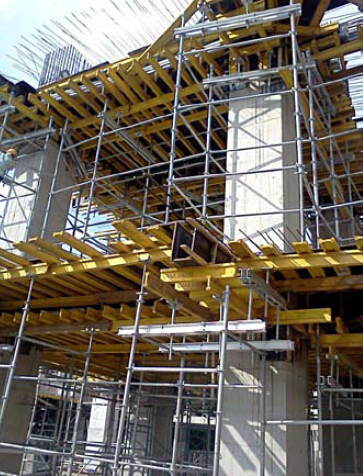
- Q: Can steel formwork be used for both small-scale and large-scale construction projects?
- Yes, steel formwork can be used for both small-scale and large-scale construction projects. Steel formwork is highly versatile and can be customized to meet the specific requirements of any construction project. It offers excellent durability and strength, making it suitable for withstanding the pressures exerted during large-scale projects. Additionally, steel formwork can be easily assembled and disassembled, allowing for efficient use on both small and large construction sites. Furthermore, steel formwork provides a smooth and consistent finish, ensuring high-quality results regardless of the scale of the project. Therefore, whether it is a small residential building or a large commercial complex, steel formwork can be effectively utilized to achieve the desired construction objectives.
- Q: How does steel formwork handle concrete bleeding?
- Steel formwork is an excellent choice for handling concrete bleeding. Concrete bleeding refers to the process where water in the concrete mixture rises to the surface, resulting in the separation of the water from the solid components. Steel formwork is designed to have a smooth and non-porous surface, which helps to prevent excessive bleeding and the loss of water from the concrete mixture. The tight joints and connections of steel formwork also minimize the chances of water seepage, ensuring that the concrete retains its desired water content. Additionally, steel formwork provides excellent support and stability to the concrete during the pouring and setting process. This prevents the formation of voids or gaps within the concrete, reducing the risk of excessive bleeding. The rigidity of steel formwork also helps to maintain the shape and structure of the concrete, preventing any deformation or cracking that may occur due to bleeding. Moreover, steel formwork allows for easy and efficient removal of excess water from the concrete surface. The smooth and non-absorbent nature of steel formwork facilitates the use of various techniques, such as squeegeeing or vacuuming, to remove the excess water, reducing the bleeding effect. In summary, steel formwork handles concrete bleeding effectively by providing a smooth and non-porous surface, minimizing water seepage, ensuring stability and support to the concrete, and allowing for efficient removal of excess water.
- Q: What are the common quality control measures for steel formwork?
- Steel formwork undergoes several quality control measures to ensure its compliance with standards and specifications: 1. Thoroughly inspect the steel formwork for visible defects or damage, such as cracks, dents, or deformations, and address them accordingly. 2. Measure the dimensions of the steel formwork, including length, width, and height, and compare them to the specified requirements. Correct any deviations from the required dimensions. 3. Conduct material testing to verify that the steel formwork meets the necessary standards and specifications. This includes testing its tensile strength, yield strength, hardness, and chemical composition. 4. Inspect the quality of welds if the steel formwork is welded. Check for proper penetration, fusion, and the absence of defects like cracks or porosity. Employ non-destructive testing methods like ultrasonic or radiographic testing to ensure the integrity of the welds. 5. Inspect the surface coating, such as paint or galvanized coating, for thickness, adhesion, and uniformity. This guarantees protection against corrosion and enhances the durability of the formwork. 6. Subject the steel formwork to load testing to evaluate its structural integrity and load-bearing capacity. Apply a known load and monitor the formwork's response to ensure it can safely support the required loads during construction. 7. Document and maintain records of the quality control measures for future reference. This includes recording inspection results, material test reports, and any corrective actions taken. By implementing these quality control measures, the steel formwork can meet the necessary standards, specifications, and safety regulations, ensuring its structural integrity and performance during construction.
- Q: What are the different types of lifting systems used with steel formwork?
- There are several types of lifting systems used with steel formwork, including manual lifting, crane lifting, hydraulic lifting, and mechanical lifting. Each system has its own advantages and is chosen based on the specific requirements of the construction project.
- Q: How does steel formwork affect the construction timeline?
- Steel formwork can have a significant impact on the construction timeline in both positive and negative ways. One of the main advantages of using steel formwork is its durability and strength. Unlike traditional wooden formwork, steel formwork can withstand multiple uses without losing its structural integrity. This means that it can be reused many times, reducing the time and effort required to set up formwork for subsequent construction phases. Additionally, steel formwork allows for faster assembly and disassembly, which can help to expedite construction timelines. Furthermore, steel formwork provides a high level of accuracy and consistency in shaping concrete structures. The precise dimensions and smooth finish achieved with steel formwork ensure that the construction process proceeds smoothly without any delays caused by rework or adjustments. This can lead to faster completion of construction projects. On the other hand, steel formwork can also introduce certain challenges that may affect the construction timeline. Firstly, steel formwork is generally heavier and requires more effort to transport and handle compared to other types of formwork. This may slow down the overall construction process, especially if there are limitations in terms of available equipment or labor. Additionally, steel formwork may require additional time for installation and dismantling compared to other formwork systems. The complexity of steel formwork systems and the need for skilled workers to handle them can result in a longer setup and removal time. This can impact the overall construction timeline, particularly when tight deadlines need to be met. In conclusion, steel formwork can have both positive and negative effects on the construction timeline. Its durability, reusability, and accuracy can help expedite the construction process. However, the weight and complexity of steel formwork may introduce additional challenges that can potentially slow down the construction timeline.
- Q: Can steel formwork be used for circular columns?
- Certainly, circular columns can be constructed using steel formwork. Steel formwork possesses great versatility and can be conveniently molded into different shapes and sizes, including circular structures. Its exceptional strength and durability make it ideal for projects requiring formwork that can withstand substantial loads and frequent utilization. Moreover, steel formwork can be easily modified and utilized repeatedly, resulting in cost-effective circular column construction. Typically, the steel formwork is meticulously designed and produced to perfectly align with the precise dimensions and radius of the circular column, guaranteeing an exact and precise formwork system.
- Q: How does steel formwork affect the cost of construction?
- Steel formwork can significantly impact the cost of construction in various ways. Firstly, steel formwork is durable and reusable, reducing the need for frequent replacements and ultimately lowering overall costs. Additionally, steel formwork allows for faster construction due to its ease of assembly and disassembly, leading to reduced labor and time expenses. Moreover, steel formwork provides superior strength and stability, which can reduce the need for additional structural support, resulting in cost savings. Finally, the flexibility of steel formwork enables it to be customized to different project requirements, optimizing material usage and minimizing waste, further impacting construction costs positively.
- Q: What are the different types of steel formwork?
- There are several different types of steel formwork used in construction projects. These include: 1. Traditional steel formwork: This type of formwork is made from steel plates and angles, and it is commonly used for simple structures or where the formwork needs to be reused multiple times. Traditional steel formwork is durable and can withstand heavy loads, but it can be time-consuming to set up and dismantle. 2. Modular steel formwork: This formwork system consists of prefabricated modules that can be easily assembled and disassembled on-site. It is highly versatile and can be used for a wide range of structures, including walls, columns, and slabs. Modular steel formwork is lightweight and easy to handle, reducing labor costs and construction time. 3. Tunnel formwork: This type of formwork is specifically designed for constructing tunnel structures. It consists of steel panels that are bolted together to create a continuous formwork system. Tunnel formwork is efficient and allows for rapid construction, making it suitable for large-scale projects such as subway tunnels or underground structures. 4. Slip formwork: Slip formwork is a method where a continuous concrete pour is used to create a vertical structure, such as a tower or chimney. Steel formwork is used to create the initial mold, which is continuously moved upward as the concrete is poured. Slip formwork allows for fast construction and is commonly used for high-rise buildings or structures with a consistent cross-section. 5. Climbing formwork: This formwork system is used for constructing tall vertical structures, such as skyscrapers or bridge piers. Steel formwork is attached to the structure and then hydraulically lifted or climbed as the construction progresses. Climbing formwork allows for continuous construction and eliminates the need for external scaffolding. Each type of steel formwork has its advantages and disadvantages, and the choice depends on the specific requirements of the project, including budget, construction time, and complexity.
- Q: How does steel formwork handle different concrete surface gloss levels?
- Steel formwork is an excellent choice for handling different concrete surface gloss levels due to its versatility and durability. The smooth and rigid nature of steel formwork allows it to create a consistent and even surface finish, regardless of the gloss level desired. When it comes to different concrete surface gloss levels, steel formwork offers several advantages. Firstly, it provides a smooth and uniform surface, which is crucial for achieving a high gloss finish. The steel panels are precisely constructed to create a seamless surface, minimizing any irregularities that could affect the gloss level. Additionally, steel formwork is highly resistant to warping or bending under the weight of the concrete, ensuring that the surface remains level and consistent. This is particularly important when aiming for a glossy finish, as any inconsistencies in the formwork could result in uneven concrete placement and subsequent variations in gloss. Furthermore, steel formwork is reusable, making it cost-effective and environmentally friendly. With proper maintenance and care, steel formwork can be used for multiple projects, allowing for consistent results in terms of gloss levels. In conclusion, steel formwork is an ideal choice for handling different concrete surface gloss levels. Its smooth and rigid construction ensures a uniform surface finish, while its durability guarantees consistent results. Steel formwork provides an efficient and effective solution for achieving various gloss levels in concrete construction projects.
- Q: Does steel formwork require any special expertise or training for installation?
- Yes, steel formwork does require special expertise and training for installation. Steel formwork is a complex system of interlocking panels and components that are used to create temporary molds for pouring concrete structures. It requires a thorough understanding of the formwork design, installation techniques, and safety procedures. Professionals who work with steel formwork need to be knowledgeable about the specific requirements of each project, including the load-bearing capacity, formwork connections, and the proper placement of reinforcement. They also need to have the skills to accurately measure and cut the steel panels, assemble them correctly, and ensure that the formwork is properly aligned and braced. In addition, expertise in steel formwork installation includes understanding the different types of formwork systems available, such as adjustable steel formwork, modular steel formwork, or tunnel formwork, and knowing how to select the most appropriate system for a particular project. This knowledge is crucial to ensure that the formwork can withstand the pressure exerted by the wet concrete and can produce a structurally sound and aesthetically pleasing final result. Furthermore, proper training in steel formwork installation is essential to ensure the safety of workers and the overall success of the construction project. This includes knowledge of safety regulations, understanding how to use personal protective equipment, and being aware of potential hazards and how to mitigate them. Overall, due to the complexity and specific requirements of steel formwork installation, it is important to have professionals with the necessary expertise and training to ensure a smooth and successful construction process.
Send your message to us
Ring-lock scaffolding Accessories for formwork and scaffolding system
- Loading Port:
- Tianjin
- Payment Terms:
- TT OR LC
- Min Order Qty:
- 50 m²
- Supply Capability:
- 1000 m²/month
OKorder Service Pledge
Quality Product, Order Online Tracking, Timely Delivery
OKorder Financial Service
Credit Rating, Credit Services, Credit Purchasing
Similar products
Hot products
Hot Searches
Related keywords
